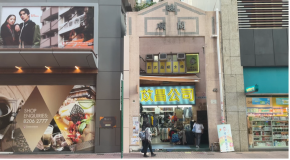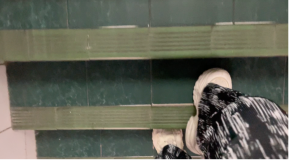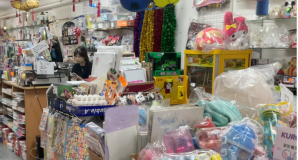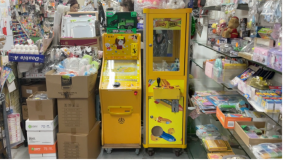Navigating the Uncertain Future of the Old-Fashioned Stationery Store
UID: 3036107505
The director’s name: Lok Shuet Ying Cherie
This video showcases a stationery store called “Dr. Stationery Boutique” located on Hong Kong Island. (Google Map, 2024) The camera initially establishes the store’s context, panning across the surrounding neighborhood to reveal the store’s unique positioning – the east side serves as the entrance to an upscale residential building, while the west side is dominated by a large Starbucks. Compared to the surrounding modern buildings, the stationery store and the clothing store below it appear quite dilapidated. (Figure 1)

Figure 1 Original video footage

Figure 2 Original video footage

Figure 3 Original video footage
A slow, steady ascent up the worn-out stairs leading to the second-floor entrance creates a sense of anticipation, as if the viewer is embarking on an exploration of an ancient, undiscovered realm. (Figure 2)Upon reaching the doorway, the camera lingers, allowing the audience to take in the full scale of the larger-than-expected store. This establishing shot sets the stage for the narrative that unfolds, highlighting the store’s enduring presence in the community despite the challenges it faces. And, the shop owner notes that, like many other decades-old stores, it faces the challenge of a lack of successors. (Figure 3)

Figure 4 Original video footage
The video then delves into the changing landscape of the stationery business. In this world of paperless learning and paperless offices, the audience for paper and pens in this stationery store is dwindling. People use digital tools like Word and Excel more, and print less. The video also observes that the game machines in the store are not as popular as phones and computers for gaming. Medium shots capture the store’s interior, showcasing its array of stationery products and the vestiges of its past, such as the traditional game machines. (Figure 4)
The stationery store may be facing renovation or even relocation. The video highlights some new elements that have been added to the store, such as printing services and package delivery, which seem to reflect the community’s evolving demands. The narrator questions whether these changes are a powerless rescue or a preparation for redevelopment.
As the viewer descends the stairs, the video leaves the audience with a question: “Will I come back? Will it still be the same when I come back here?” As the viewer descends the stairs, the camera lingers, leaving them with a sense of uncertainty about the store’s fate.
Overall, the slow, contemplative pacing reflects that the stationery store, like many other such establishments, is at a crossroads, navigating the challenges of a rapidly changing landscape while trying to maintain its unique character and serve the evolving needs of the community. Throughout the video, the cinematography employs a combination of close-ups and medium shots to provide a more intimate perspective.
My research and video production process can be broadly divided into three stages: exploration, development, and production.
In the exploration stage, I conducted on-site visits to several neighborhoods, including Mong Kok, the central part of Tsing Yi Island, and the Kennedy Town area. I ultimately chose a stationery store in Kennedy Town as the focus, as it exhibited unique characteristics such as a long history, dilapidated architecture, lack of successors, and an impending relocation – features that were more pronounced compared to other stationery stores.
During the development stage, I interviewed the store owner and thoroughly documented the site through photography. I first created a mood board, carefully selecting images and extracting relevant colors to convey the my sense of nostalgia and decay associated with the stationery store. (Deguzman, 2023) I then designed a story board, envisioning various shot compositions to effectively capture the store’s distinct features. (Leighfield, 2024)
In the production stage, I proceeded to film on-site according to the storyboard plans. I then incorporated my own voiceover narration as well as the store owner’s interview audio to help the audience better understand the central theme of the video.
The video explores the impending changes facing a stationery store in the Hong Kong Island district, which prompts me to reflect on the broader issue of urban redevelopment. Historically, the focus has been on creating new urban landscapes. (O’Neill & Roberts, 2020) However, the consensus has now shifted from “demolition” to “renewal.” Designers now grapple with the question of “how to protect and renew” rather than “whether to protect or not.” (Yang, 2010) Clearly, urban renewal has become an unavoidable task for city designers.
Firstly, urban renewal often clearly reveals the needs of the community residents. The video features the stationery store’s adoption of electronic payment options and the presence of printing services and courier delivery, which reflect the evolving needs of urban dwellers. Renowned Chinese architect Wang Shu has discussed how he persuaded a local official to preserve unauthorized constructions, as these self-initiated structures and forms truly represent the needs of the community. He has consistently advocated for recognizing the renewal elements that emerge organically from urban residents, as they embody the rhythms of urban life. (Wohler, 2010) The renewal elements within the stationery store are a manifestation of the needs of its patrons.
Moreover, the changes in the city also serve as important references for designers’ redevelopment efforts. In the video, I posed the question of whether to helplessly save or prepare for the redevelopment. The stationery store faces various challenges, such as the broader trend of paperless learning and the impending relocation. However, this does not mean that the store’s current efforts are in vain. Pre-redevelopment investigation is crucial – only by understanding the timeline of changes in the neighborhood can one achieve the continuity of memory, formal renewal, and functional upgrades (SONG QIAN & FENG, 2021). The services added by the stationery store provide valuable insights for those responsible for redevelopment.
City designers must not only have the ability to create “new” projects but also the capacity to generate the “new” from the “old.” (Shin, 2009) In the case of the Stationery Store, redevelopment may not only involve constructing on the existing building, but more importantly, it should be built upon the store’s rich cultural heritage and community identity. As Jane Jacobs famously states that it is easy to make dreams, but hard to make living cities. Designing a brand-new, creative project may be relatively straightforward, but creating a truly authentic, historically respectful, and functionally innovative project on an existing structure is far more challenging.
References
Alexiou, A. S. (2006). Jane Jacobs : urban visionary. Rutgers University Press.
SONG, J., QIAN, C., FENG, Z., & MA, L. (2021). Measuring residents’ anxiety under urban redevelopment in China: An investigation of demographic variables. Frontiers of Engineering Management, 8(1), 48–59. https://doi.org/10.1007/s42524-020-0131-3
Google Map. (2024) Dr. Stationery Boutique. Google Map. https://www.google.com/maps/place/博士文具精品/@22.2828676,114.1290112,18z/data=!4m7!3m6!1s0x3403fff6bca6f2a9:0x9aa61d40b555e3c0!8m2!3d22.282866!4d114.1298309!10e1!16s%2Fg%2F11vljm7x14?entry=ttu
Deguzman. K. (2023, May 21) How to Make a Mood Board — A Step-by-Step Guide. Studiobinder. https://www.studiobinder.com/blog/how-to-make-a-mood-board/
Leighfield, L. (2024, April 11) How to Storyboard: Our 4-Step Guide to the Storyboarding Process. Boords.https://boords.com/how-to-storyboard
Wohler, T. (2010). Ningbo Museum by Pritzker prize winner Wang Shu. emap Publishing Limited. https://www.architectural-review.com/buildings/ningbo-museum-by-pritzker-prize-winner-wang-shu
O’Neill, M., & Roberts, B. (2020). Walking methods : research on the move. Routledge.
Yang, C. (2010). A study on the process reengineering of demolition and relocation for urban renewal in guangzhou city. Huazhong University of Science and Technology.
Wang, S. (2017). Imagining the House. Hunan Fine Arts Publishing House.
Shin, H. B. (2009). Residential Redevelopment and the Entrepreneurial Local State: The Implications of Beijing’s Shifting Emphasis on Urban Redevelopment Policies. Urban Studies (Edinburgh, Scotland), 46(13), 2815–2839. https://doi.org/10.1177/0042098009345540
I enjoyed looking at the shop’s interior and exterior accompanied by figures in the writing portion. This visual employs two neat methods of storytelling using slower, contemplating pacing of medium and closeup shots for maximum nostalgia. I also liked the selected images and colors with the twist of including with visible aging is distracted from the store owner like Minison the unique culture. Overall I don’t have any specific questions but can only wait for it to get better each time I watch it to unravel newer layers being uncovered.